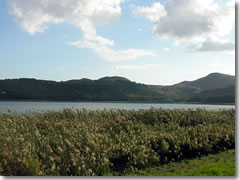- Places
- Plans
- Itineraries
- Experiences
The main drag in town, Via Roma, rises steadily through several piazzas on its way to the castle (below).
The Duomo was rebuilt in the 15th century, but retains a few Gothic elements from its 1307 roots. A Gagini carved the fantastical column capitals inside, writhing with monsters and human figures; the altar paintings along the right aisle are by Guglielmo Borremnans. It's open daily 9am to 1pm and 4 to 7pm.
Next door is the small Museo Alessi (tel. +39-0935-503-165 or +39-0935-507-6304), offering a good view of the church's Gothic apse along with Greek and Roman coins, 14th– to 18th-century paintings, and items from the Cathedral Treasury such as a 17th-century gold crown fitted with crystal and studded with jewels (it used to fit a statue of the Madonna). It's open Tuesday to Sunday 9am to 1pm and 4 to 7pm (adm).
Across the square at Piazza Mazzini 8 is Enna's other little museum, the Museo Archeologico Regionale di Palazzo Varisano (tel. +39-0935-528-100), barely worth the platry admission for its minor local artifacts from the Neolithic and Bronze Ages—though there are some nice Greek vases, and Roman remains. It is open Monday to Friday 9am to 1pm (adm).
At the end of Via Roma sits Frederick II's 13th-century Castello di Lombardia , which retains six of its original 20 towers (climb to tallest for a spectacular view over the town and countryside) and several courtyards used as open-air theaters in summer. (Via Lombardia, 24; tel. +39-0935-500-962; www.icastelli.it; open daily 9am–1pm and 3pm–5pm)
Beyond it is the windswept Rocca di Cerere, a rocky outcropping at the top of town with an edge of the world feel. The vistas of the Sicilian landscape from up here are great, but they're even better in the Lower Town at the Torre di Frederico II, an octagonal tower built by the Norman king at the precise center of the island. They say that from the top, on the clearest day, you can see all of Sicily.
There is some debate as to whether it as under the Rocca or the Torre that the pre-Greek Sicani built their temple to Demeter (Ceres in Latin), goddess of fertility, agriculture, and the harvest.
Yes, that's right: I said Demeter was a pre-Greek goddess. Not all of what we consider Greek legends were Attic in origin; some had their genesis here in Magna Graecia, or Greater Greece—and many were actually borrowed from much, much older local myths of the native Sikel and Sicani tribes. The famous "Rape of Persephone," Demeter's daughter, is one of them.

Lake Pergusa, outside Enna, where one of the most famous myths of Greek antiquity took place: The Rape of Persephone.If you stand on the edge of the forlorn clifftop at the Torre di Frederico II and look southeast (about 45° to your right), you'll see the small ★ Lago di Pergusa.
It was by the reedy shores of this lake that Persephone was picking flowers when Hades, Lord of the Underworld and one of the Big Three gods of the ancient Greeks, burst from the ground in his chariot, grabbed the maiden, and rode back to the underworld to make her his queen.
Just in case your famous ancient Greek myths are rusty: Persephone pined away in the underworld, a miserable prisoner of her new husband, while her mother, Demeter, goddess of the harvest (and fertility), abandoned her duties to spend all of her time searching for her lost daughter, causing a never-ending winter to descend upon the Earth.
Upon eventually learning of Persephone's fate, Demeter demanded that Zeus intervene, and the gods struck a deal: Persephone could return to her mother so long as she had not eaten anything in the underworld.
Alas, Persephone had nibbled just six pips from a pomegranate, so a compromise was reached. Persephone would spend six months of each year living in Hell as its Queen, and the other six months back up on the Earth with her mother.
Whenever her daughter returns to her, Demeter rejoices and the land bursts forth with the new life of spring buds. The two spend their summers happily in each other company, but as the day approaches when Persephone must once again take up her crown with Hades, Demeter saddens, crops begin to wither, and plants start to die. Each year, once Persephone is ensconced again on the throne of Hell, Demeter wallows in her grief and winter descends once again upon the lands of the Earth.
And that is how the Greeks explained the seasons.
Share this page
Search ReidsItaly.com
Tourist info Enna:
Via Roma 411
tel. +39-0935-528-288
www.comune.enna.it
Hotels in Enna
www.booking.com
www.airbnb.com
www.bedandbreakfast.com
www.hostelworld.com